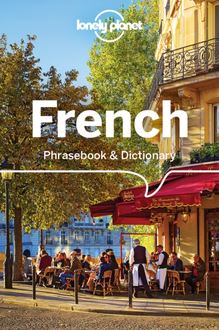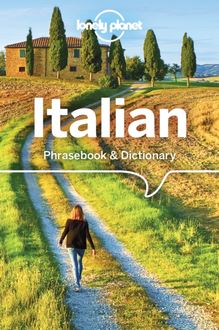Lonely Planet Spanish Phrasebook & Dictionary with Audio , livre ebook
301
pages
English
Ebooks
2018
Vous pourrez modifier la taille du texte de cet ouvrage
Obtenez un accès à la bibliothèque pour le consulter en ligne En savoir plus
Découvre YouScribe en t'inscrivant gratuitement
Découvre YouScribe en t'inscrivant gratuitement
301
pages
English
Ebooks
2018
Vous pourrez modifier la taille du texte de cet ouvrage
Obtenez un accès à la bibliothèque pour le consulter en ligne En savoir plus
Publié par
Date de parution
01 septembre 2018
Nombre de lectures
6
EAN13
9781788686341
Langue
English
Poids de l'ouvrage
8 Mo
Publié par
Date de parution
01 septembre 2018
Nombre de lectures
6
EAN13
9781788686341
Langue
English
Poids de l'ouvrage
8 Mo
Spanish audio phrasebook
September 2018
Published by
Lonely Planet Global Limited CRN 554153
Cover Image
Marbella nightlife. Maurizio Rellini/4Corners
ISBN 9781788686341
Text Lonely Planet 2018
All rights reserved. No part of this publication may be reproduced, stored in a retrieval system or transmitted in any form by any means, electronic, mechanical, photocopying, recording or otherwise, except brief extracts for the purpose of review, without the written permission of the publisher.
Lonely Planet does not allow its name or logo to be appropriated by commercial establishments, such as retailers, restaurants or hotels. Please let us know of any misuses: www.lonelyplanet.com/ip .
Lonely Planet and the Lonely Planet logo are trade marks of Lonely Planet and are registered in the US Patent and Trademark Office and in other countries.
Although the authors and Lonely Planet try to make the information as accurate as possible, we accept no responsibility for any loss, injury or inconvenience sustained by anyone using this book.
acknowledgments
This edition of Lonely Planet s Spanish phrasebook is based on the previous editions by the Lonely Planet Language Products team, Marta L pez for the Spanish translations and pronunciation guides, and Peter and Marta Gibney as proofers of the Spanish text.
Lonely Planet s Language Products team consists of: Tali Budlender (Associate Publisher), Annelies Mertens (Managing Editor), Branislava Vladisavljevic and Laura Crawford (Editors), Celia Wood (Managing Layout Desiger), Wibowo Rusli (Layout Desiger), Wayne Murphy (Cartographer), Yvonne Kirk and Glenn van der Knijff (Production Support).
Thanks also to the others who contributed to the previous editions on which this one is based: Jane Atkin, Julie Burbidge, Karina Coates, Francesca Coles, Adrienne Costanzo, Ben Handicott, Jim Jenkin, Piers Kelly, Yukiyoshi Kamimura, Emma Koch, Paul Piaia, Fabrice Rocher, Karin Vidstrup Monk, Meg Worby, and last but not least, Daniel New who created the inside illustrations.
Table of Contents
INTRODUCTION
language map
introduction
TOOLS
pronunciation
a-z phrasebuilder
language difficulties
numbers amounts
time dates
money
PRACTICAL
transport
border crossing
accommodation
directions
shopping
communications
business
banking
sightseeing
disabled travellers
children
SOCIAL
meeting people
interests
feelings opinions
going out
romance
beliefs cultural differences
sports
outdoors
FOOD
eating out
self-catering
vegetarian special meals
culinary reader
SAFE TRAVEL
essentials
health
SUSTAINABLE TRAVEL
DICTIONARIES
english-spanish dictionary
spanish-english dictionary
There is audio and/or video content in this eBook that may not be supported on your device.
make the most of this phrasebook ...
Anyone can speak another language! It s all about confidence. Don t worry if you can t remember your school language lessons or if you ve never learnt a language before. Even if you learn the very basics, your travel experience will be the better for it. You have nothing to lose and everything to gain when the locals hear you making an effort.
finding things in this book
For easy navigation, this book is in sections. The Tools chapters are the ones you ll thumb through time and again. The Practical section covers basic travel situations like catching transport and finding a bed. The Social section gives you conversational phrases, pick-up lines, the ability to express opinions - so you can get to know people. Food has a section all of its own: gourmets and vegetarians are covered and local dishes feature. Safe Travel equips you with health and police phrases, just in case. Remember the colours of each section and you ll find everything easily; or use the hyperlinks provided in the Table of Contents. Otherwise, check the two-way traveller s Dictionary for the word you need.
being understood
Throughout this book you ll see coloured phrases beneath each translation. They re phonetic guides to help you pronounce the language. You don t even need to look at the language itself, but you ll get used to the way we ve represented particular sounds. The pronunciation chapter in Tools will explain more, but you can feel confident that if you read the coloured phrase slowly, you ll be understood.
using the audio
You ll notice the audio icons beneath a selection of phrases in this book. Use the audio to help master your own pronunciation, or use it on the road by letting it do some of the talking for you.
For more details, see the introduction .
INTRODUCTION
introducci n
Spanish, or Castilian, as it s also called in Spain, is the most widely spoken of the Romance languages, the group of languages derived from Latin which includes French, Italian and Portuguese. Outside Spain, it s the language of most of Latin America and the West Indies and is also spoken in the Philippines and Guam, as well as in some areas of the African coast and in the US. Worldwide, there are more than 30 countries or territories where Spanish is spoken.
Spanish is derived from Vulgar Latin, which Roman soldiers and merchants brought to the Iberian Peninsula during the period of the Roman conquest (3rd to 1st century BC). By 19 BC Spain had become totally Romanised and Latin became the language of the peninsula in the four centuries that followed. Today s Castilian is spoken in the north, centre and south of Spain.
People are intensely proud of their language and generally expect visitors to know at least a little. English is less widely spoken in Spain than in many other European countries, especially out-side the major cities.
This book gives you the practical words and phrases you need to get by, and the fun, spontaneous phrases that lead to a better experience of Spain and its people. Need more encouragement?
at a glance ...
language name: Spanish
name in language: Espa ol es pa nyol
language family: Romance
key country: Spain
approximate number of speakers: over 390 million worldwide
close relatives: Latin American Spanish, Portuguese, Italian
donations to english: alligator, bonanza (lit: fair weather), canyon, guerilla, rodeo, ranch, stampede, tornado and many more familiar words ...
Remember, the contact you make through using Spanish will make your travels unique. Local knowledge, new relationships and a sense of satisfaction are on the tip of your tongue, so don t just stand there, say something!
basque, catalan galician
We also give you the basics of these languages because they are each considered official in Spain, even though Spanish, or Castilian, covers by far the largest territory.
Basque, a non-latin language, is spoken in parts of the north. Catalan is spoken in the east and Galician in the north-west. These last two are also Romance languages, so are closer in origin to Spanish.
If you re travelling widely in Spain, see the special section on these regional languages for some basic expressions .
abbreviations used in this book
f feminine inf informal m masculine sg singular pl plural pol polite
TOOLS pronunciation
herramientas de pronunciaci n
word stress
vowel sounds
consonant sounds
Spanish pronunciation isn t hard, as many sounds are similar to sounds used in English.
There are some easy rules to follow and once you learn them it s likely you ll be understood.
The relationship between Spanish sounds and their spelling is straightforward and consistent.
Like most languages, pronunciation can vary according to region. This book focuses on Castilian Spanish.
word stress
nfasis
There is stress in Spanish, which means you emphasise one syllable over another. Rule of thumb: when a written word ends in n , s or a vowel, the stress falls on the second-last syllable. Otherwise, the final syllable is stressed.
If you see an accent mark over a syllable, it cancels out these rules and you just stress that syllable instead.
vowel sounds
vocales
symbol english equivalent spanish example a a lms a gua e r e d n m e ro ee b ee d a o g o o jo oo b oo k g u sto ai ai sle b ai lar ow c ow au tob s oy b oy h oy
consonant sounds
consonantes
symbol english equivalent spanish example b b ig b arco ch ch illi ch ica d d in d inero f f un f iesta g g o g ato k k ick c abeza/ qu eso kh lo ch j ard n/ g ente l l oud l ago ly mi lli on ll amada m m an m a ana n n o n uevo ny ca ny on se ora p p ig p adre r r un, but stronger and rolled r itmo/bu rr o s s o s emana t t in t ienda th th in Bar c elona/man z ana v soft b , somewhere between v and b a b rir w w in g ua rdia y y es v i aje
There are some key things to remember about consonants in Spanish writing:
the letter c is pronounced with a lisp, bar the lo na (Barcelona), except when it comes before a , o and u or a consonant, when it s hard like k in king .
when ending a word, the letter d is also soft, like a th , or it s so slight it doesn t get pronounced at all.
the Spanish letter j stands for a harsh and gutteral sound, so we use a kh symbol in our phonetic guides.
try to roll your double r s.
the letter q is pronounced hard like a k .
the letter v sounds more like a b , said with the lips pressed together.
there are a few letters which don t appear in the English alphabet: ch , ll and . You ll see these have their own entries in the spanish-english dictionary.
spanish alphabet a A a b B be c C the ch CH che d D de e E e f F e fe g G khe h H a che i I ee j J kho ta k K ka l L e le ll LL e lye m M e me n N e ne e nye o O o p P pe q Q koo r R e re s S e se t T te u U oo v V oo ve w W oo ve do vle x X e kees y Y ee grye ga z Z the ta
false friends
Beware of false friends - those words that sound like familiar English, but could land you in a bit of trouble if you use them unwittingly in Spanish. Here are some mistakes it s a little too easy to make:
slum district
el suburbio
el soo boor




